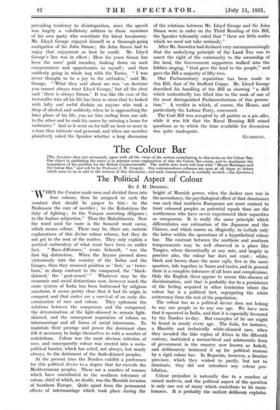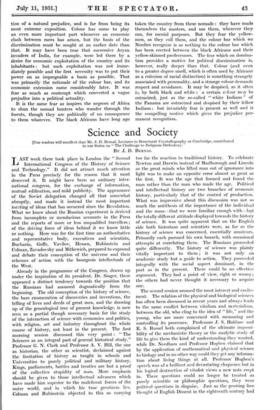The Colour Bar
[The Spectator does not necessarily agree with all the views of the writers contributing to this series on the Colour Bar. Our object iri publishing the series is to attempt some explanation of why the ColoUr Bar existe, and to emphasize the importance of the problem for the British Commonwealth. The article next week will deal with "Mixed Marriages and the Colour Bar," and will be by Professor J. W. Gregory. Our correspondence columns are open at all times to letters which seem to us to add to the interest of this discussion ; and such correspondence is cordially invited.—ED.Spectatorl
The Political Aspect of Colour
BY J. H. DRIBERG.
" WHEN the Creator made men and divided them into four colours, then he assigned to each the conduct that should be proper to him : to the Brahmans the care of sacrifice ; to the Kshatriyas the 'day of fighting ; to the Vaisyas unresting diligence ; to. the Sudras subjection." Thus the Mahabharata. Now the word used for caste is the Sanscrit word varna, which means colour. There may be, there are, esoteric explanations of this divine colour scheme, but they do not get to the root of the matter. They only explain a poetical embroidery of what must have been an earlier fact. "Race-difference," wrote Schmidt, "was the first big distinction. When the Aryans pressed down victoriously into the country of the Indus and the Ganges, then they assumed position as 'first,' as 'twice- born,' in sharp contrast to the conquered, the 'black- skinned,' the ' goat-nosed.' " Whatever may be the 'economic and social distinctions now, however much the caste system of India has been buttressed by religious sanctions, it seems pretty clear that it had its origin in conquest and that castes are a survival of an early dis- crimination of race and colour. They epitomise. the relations between the conquerors and the conquered, the determination of the light-skinned to remain light- skinned, and the consequent imposition of taboos on intermarriage and all forms of social intercourse. To maintain their prestige and power the dominant class felt it necessary to hedge themselves in with a number of restrictions. Colour was the most obvious criterion of race, and consequently colour was erected into a socio- political barrier, which has acted, not always, but nearly always, to the detriment of the dark-skinned peoples.
At the present time the Nordics exhibit a preference for this political device to a degree that far exceeds the Mediterranean peoples. There are a number of reasons which have contributed to the southern tolerance of colour, chief of which, no doubt, was the Moorish invasion of Southern Europe. Quite apart from the permanent effects of intermarriage which took place during the height of Moorish power, when the darker race was in the ascendancy, the psychological effect of that dominance was such that southern Europeans are more content to treat coloured peoples as potential equals than are the northerners who have never experienced their capacities as conquerors. It is really the same principle which differentiates our estimation of the Japanese and the Chinese, and which causes us, illogically, to include only the latter within the operations of a hypothetical colour bar. The contrast between the northern and southern temperaments may be well observed in a place like Tangier, where theoretically at any rate, and largely in practice also, the colour bar does not exist : white, black and brown share the same cafes, live in the same quarters, ride together in 'buses and taxies, and in general there is a complete tolerance of all hues and complexions. Only the English there appear to resent this absence of discrimination, and that is probably due to a persistence of the feeling- acquired in other territories where the colour bar is a political fact, segregating the white aristocracy from the rest of the population.
The colour bar as a political device does not belong to any one people or to any one age. We have seen that it operated in India, and that it is especially favoured by the Nordics to-day. But examples of its use might be found in nearly every age. The Gala, for instance, a Hamitic and technically white-skinned race, when they invaded the lake region of Africa in the fifteenth century, instituted a monarchical and aristocratic form of government in the country now known as Ankoli, and deliberately bolstered it up for political reasons by a rigid colour bar. In Buganda, however, a frontier province, which they wished to pacify, but not to dominate, they did not introduce any colour pro- hibition.
Colour prejudice is naturally due to a number of mixed motives, and the political aspect of the question is only one out of many which contribute to its main- tenance. It is probably the earliest 'deliberate exploiti. tion of a natural prejudice, and is far from being its most extreme exposition. Colour has come to play an even more important part whenever an economic clash between races has arisen, but the basis of the discrimination must be sought at an earlier date than that. It may have been true that successive Aryan invaders of India, for example, were led there by a desire for economic exploitation of the country and its inhabitants : but such exploitation was not imme- diately possible and the first necessity was to put their power on as impregnable a basis as possible. That was primarily the rationale of the colour bar, and its economic extension came considerably later. It was fear as much as contempt which converted a vague prejudice into a political actuality.
It is the same fear as inspires the negroes of Africa to shun the nomad hunters who wander through the forests, though they are politically of no consequence to them whatever. The black Africans have long ago taken the country from these nomads : they have made themselves the masters, and use them, wherever they can, for menial purposes. But they fear the yellow- men, as they call them, and the colour bar which we Nordics recognize is as nothing to the colour bar which has been erected between the black Africans and their yellow-skinned predecessors. The fear which on domina- tion provides a motive for political discrimination is, however, really deeper than that. Colour (and even to a greater degree smell, which is often used by Africans as a criterion of racial distinction) is something strangely associated with personality, and a strange colour demands respect and avoidance. It may be despised, as it often i3, by both black and white : a certain colour m3y be ostracized, just as the so-called "white Indians" of the Panama are ostracized and despised by their fellow Indians : but invariably fear is present as well and is the compelling motive which gives the prejudice per- manent recognition.



































 Previous page
Previous page